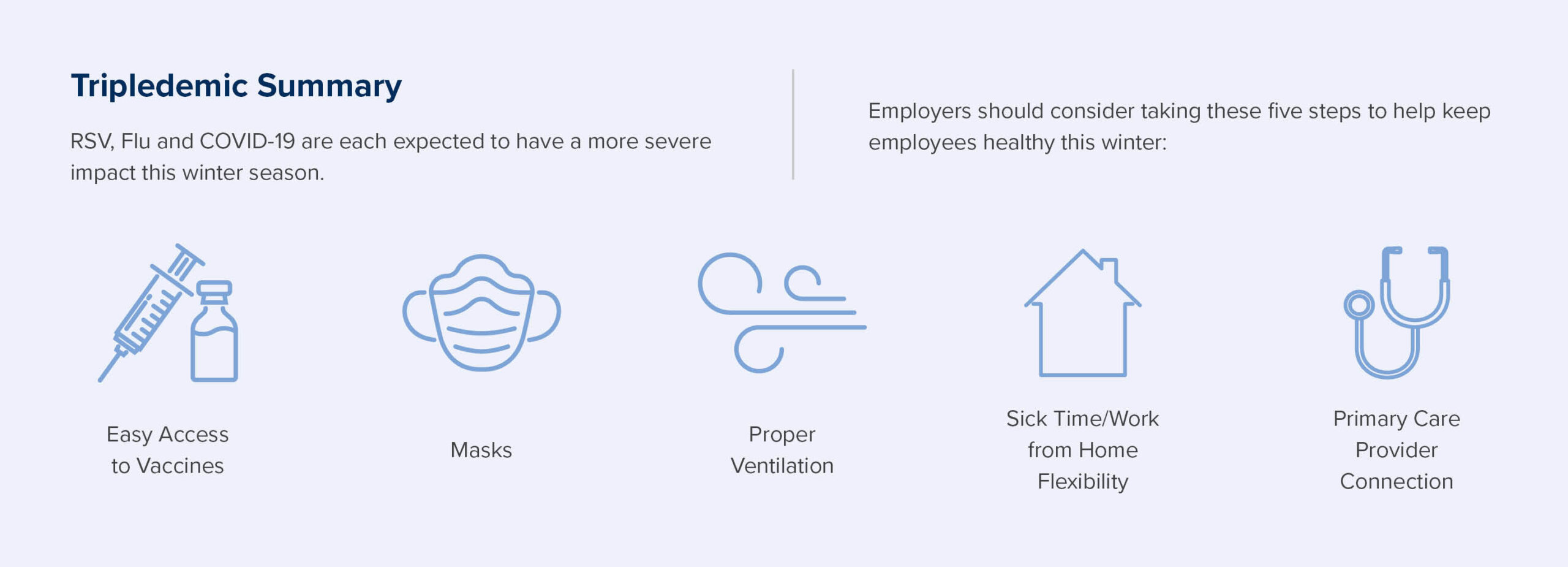The “Tripledemic” | What Employers Should Know and Do Going into Winter
Employee Benefits
The “Tripledemic” | What Employers Should Know and Do Going into Winter
The U.S. is fighting a threat of surging cases of three respiratory viruses – respiratory syncytial virus (RSV), the flu and COVID-19 – which is being referred to as the “tripledemic.”
Overview
RSV
RSV is a common respiratory virus with the potential to cause life-threatening lung infections in infants, older adults and immunocompromised people.1 This viral illness spreads in the air through coughing and sneezing, direct contact and touching an object or surface with the virus on it. Symptoms include a runny nose, decreased appetite, cough, sneezing, fever and wheezing. In average years, RSV sends thousands of children to the hospital over fall and winter, but for the second year in a row, experts have seen an unprecedented spike in the number of cases beginning during the summer months.2
Flu
Another viral disease, also known as influenza, the flu is a contagious respiratory illness that can affect the nose, throat and sometimes the lungs.3 Flu viruses typically circulate during the fall and winter during what is known as the flu season. This flu season is looking to be more severe than the recent past going back to 2010-2011. Early increases in seasonal influenza activity continue, with the southeast and southcentral areas of the country reporting the highest levels of activity. The CDC estimates that, so far this season, there have been at least 880,000 flu illnesses, 6,900 hospitalizations and 360 deaths from the flu.4
COVID-19
COVID continues to circulate, and people are feeling the short- and long-term impacts. This virus is a highly contagious respiratory disease that can have an ongoing effect on multiple body systems. The CDC reports that one-in-five American adults who have had COVID still have symptoms of Long COVID.5 Currently, there are several variants of concern around the world that scientists are tracking.6 These newer variants are evolving from the Omicron strain and differ from the native strain and Delta. There is concern that one or more of these new variants could lead to a winter surge of COVID in the U.S. and other parts of the world. Countries in Europe are seeing spikes in cases and resource utilization, which may foreshadow what the U.S. can expect going into the fall and winter. 7
Five Steps to Help Keep Your Workforce Healthy This Winter
To help protect your employees from the “tripledemic,” you should:
- Make vaccinations accessible. Logistics and costs are often major barriers to getting seasonal vaccines like the flu shot and boosters for COVID. Provide information on local pharmacies and clinics that offer COVID and flu vaccines. Remind your insured employees that these are fully covered by their health plan and provide vouchers to cover the costs for the uninsured. Give employees paid time off to get immunized.
- Continue to encourage or require mask-wearing, which limits the spread of each of these respiratory diseases. This is especially important if you have employees in routine close contact with one another, customers or the public.
- Ensure proper ventilation in buildings and workspaces, which may reduce the concentration of airborne viruses. It can also reduce surface contamination, especially important for RSV and the flu, by removing some virus particles before they land on surfaces. Professionals who operate school, office and commercial buildings should consult guidance by ASHRAE for information on ventilation and air filtration to help reduce the risks of these viruses.8
- Given the contagiousness of all three viral illnesses, encourage employees to stay home if they are not feeling well and are symptomatic. Offering paid sick time, or ways to work from home can help decrease the likelihood of a workplace outbreak. If someone is feeling sick, local and state resources can help connect people with testing and treatment, especially for COVID.
- Help employees get connected to a primary care provider (PCP), so they have treatment options in the event they do become ill or have symptoms. A primary care provider can help with testing for different viruses and give guidance on over the counter and prescription treatments. Seeking routine and early care from a PCP lowers the likelihood that high-cost emergency care becomes necessary.

Five Steps to Help Keep Your Workforce Healthy This Winter
To help protect your employees from the “tripledemic,” you should:
- Make vaccinations accessible. Logistics and costs are often major barriers to getting seasonal vaccines like the flu shot and boosters for COVID. Provide information on local pharmacies and clinics that offer COVID and flu vaccines. Remind your insured employees that these are fully covered by their health plan and provide vouchers to cover the costs for the uninsured. Give employees paid time off to get immunized.
- Continue to encourage or require mask-wearing, which limits the spread of each of these respiratory diseases. This is especially important if you have employees in routine close contact with one another, customers or the public.
- Ensure proper ventilation in buildings and workspaces, which may reduce the concentration of airborne viruses. It can also reduce surface contamination, especially important for RSV and the flu, by removing some virus particles before they land on surfaces. Professionals who operate school, office and commercial buildings should consult guidance by ASHRAE for information on ventilation and air filtration to help reduce the risks of these viruses.8
- Given the contagiousness of all three viral illnesses, encourage employees to stay home if they are not feeling well and are symptomatic. Offering paid sick time, or ways to work from home can help decrease the likelihood of a workplace outbreak. If someone is feeling sick, local and state resources can help connect people with testing and treatment, especially for COVID.
- Help employees get connected to a primary care provider (PCP), so they have treatment options in the event they do become ill or have symptoms. A primary care provider can help with testing for different viruses and give guidance on over the counter and prescription treatments. Seeking routine and early care from a PCP lowers the likelihood that high-cost emergency care becomes necessary.
1 RSV (Respiratory Syncytial Virus) | CDC.
2 https://www.npr.org/2022/11/02/1133040571/rsv-questions-answers-treatment-options
3 Key Facts About Influenza (Flu) | CDC
4 https://www.cdc.gov/flu/weekly/index.htm
5 Basics of COVID-19 | CDC
6 https://www.who.int/activities/tracking-SARS-CoV-2-variants
7 Omicron, Delta, Alpha, and More: What To Know About the Coronavirus Variants > News > Yale Medicine
8 https://www.epa.gov/coronavirus/ventilation-and-coronavirus-covid-19

